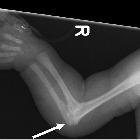Radioulnare Synostose


Kongenitale
Radiusköpfchenluxation beidseits bei einem zweijährigen Mädchen. Röntgenbild a.p. und seitlich. Das proximale Ende des Radius zeigt nicht auf den Knochenkern des Capitulum humeri. Der Befund ist rechts ausgeprägter als links. Ausserdem fällt eine Sklerose am proximalen radioulnaren Gelenk auf, was als Hinweis auf eine Synostose zu werten ist. Klinisch Supinationsdefizit beidseits, rechts auch Streckdefizit.

Kongenitale
Radiusköpfchenluxation beidseits bei einem zweijährigen Mädchen. Röntgenbild a.p. und seitlich. Das proximale Ende des Radius zeigt nicht auf den Knochenkern des Capitulum humeri. Der Befund ist rechts ausgeprägter als links. Ausserdem fällt eine Sklerose am proximalen radioulnaren Gelenk auf, was als Hinweis auf eine Synostose zu werten ist. Klinisch Supinationsdefizit beidseits, rechts auch Streckdefizit.


Prenatal
diagnosis of pfeiffer syndrome type II using ultralow dose CT. Plain radiographs of the right upper extremity shows radio-ulnar-humeral synostosis (arrow).

Novel
phenotypes and genotypes in Antley-Bixler syndrome caused by cytochrome P450 oxidoreductase deficiency: based on the first cohort of Chinese children. The skeletal X-ray results of Chinese children with ABS caused by PORD. Notable skeletal abnormalities included clinodactyly of the 5th fingers (red arrow), brachydactyly (green arrow, short distal phalanges for patient 1; short 3rd and 4th toes for patients 6; short 4th toes for patients 8), short 4th metacarpals (black arrow), and abnormal bone fusion (blue arrow, fusion between the lateral cuneiform bone and cuboid bone for patient 1; radioulnar synostosis for patient 7)
Radioulnare Synostose
Siehe auch:
- Radiusköpfchenfraktur
- kongenitale Radiusköpfchenluxation
- congenital proximal radioulnar synostosis
- Klinefelter-Syndrom
- Aase-Smith-Syndrom
- Williams-Beuren-Syndrom
- OFM Nager-Syndrom
- proximal radioulnar synostosis
- post-traumatic radioulnar synostosis
- XYY-Syndrom
- Mesomele Dysplasie Typ Nievergelt
- WT syndrome
- Kamptomele Dysplasie
und weiter:

 Assoziationen und Differentialdiagnosen zu Radioulnare Synostose:
Assoziationen und Differentialdiagnosen zu Radioulnare Synostose:
